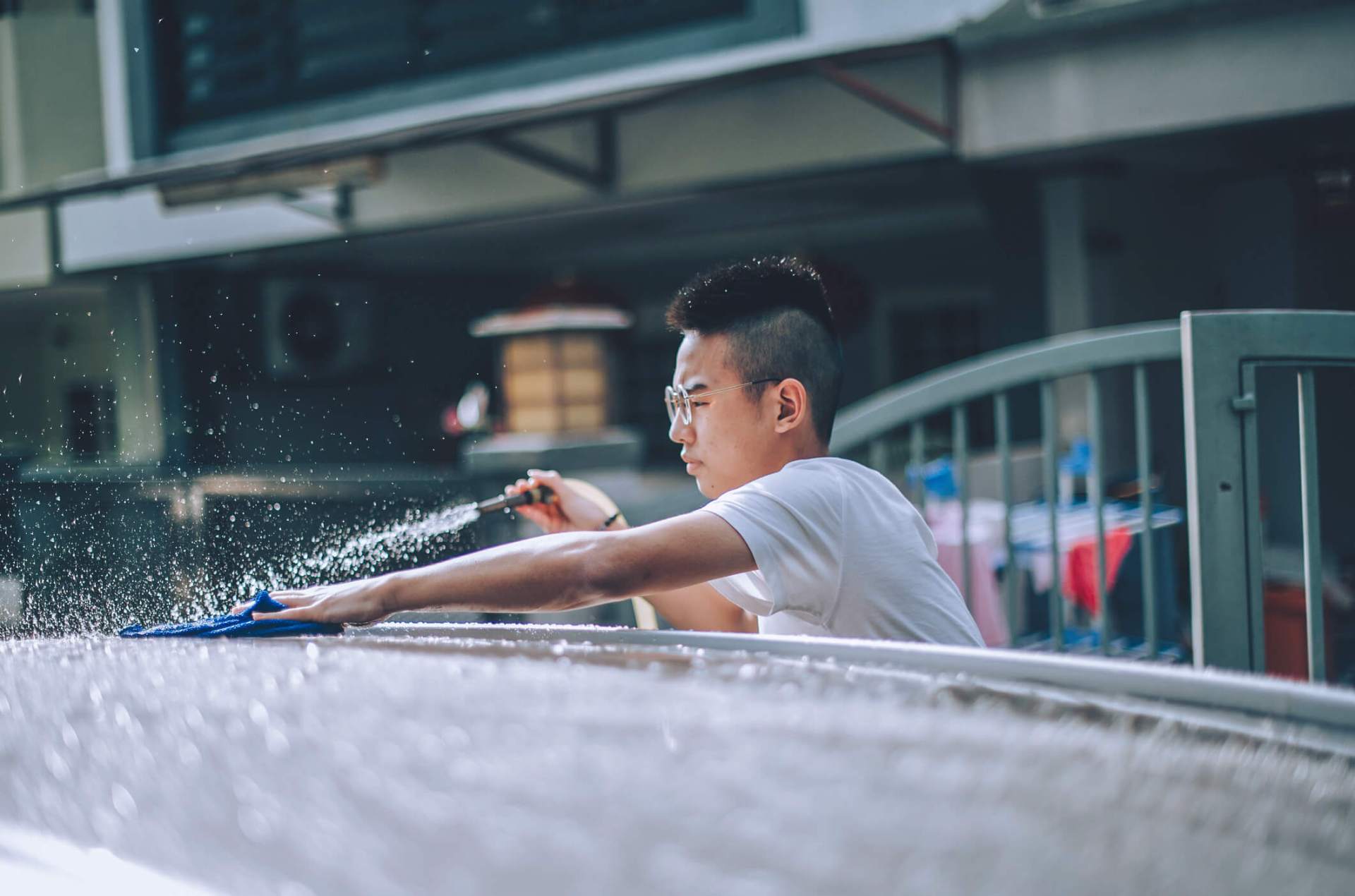If you, as a parent, find yourself doing most of the chores around the house, it may be time to assign more tasks to your tweens and teens. Not only does giving your kids daily chores help lighten your load, but taking on those responsibilities will also prepare them for adult life, like when they will need to manage homes of their own.
Did you just groan at the idea of managing a list of chores for your kids? We get it. Researching age-appropriate chores, staying on top of your kids’ list of chores and even creating chore agreements can be, well, a bit of a chore. That’s why we created this guide. With some of the tips you’ll find here, you’ll (finally!) get help around the house while preparing your kids for their future.
In fact, add in a weekly allowance tied to a chart for chores (more on that below), and the lessons extend to money management. After all, financial literacy is a key component of adulting. Earning money—and spending it!—is one of the best ways to practice.
Since your kids probably live on TikTok and Instagram, using an app to track and manage their chores and allowance is an easy way to teach financial skills. That’s where Mydoh comes in. It’s a money management app and Smart Cash Card for parents and kids that helps encourage good decision-making around money. Through the app, you can coach your teens and tweens on the value of a dollar.
What are chores?
Daily chores and weekly chores are ingrained in grown-up life that we sometimes forget what they actually are. Taking out the garbage and recycling, emptying the dishwasher, and vacuuming are just a few of the chores around the house that never seem to end. That’s the point: They repeat. Like painting the porch, a once-in-a-few-years job isn’t a chore, but folding laundry or sweeping the floor are definitely house chores.
Why are chores important?
Kids may beg to differ, but, according to research, doing age-appropriate chores is vital at all childhood stages, even for children as young as three. That’s because household chores boost kids’ sense of responsibility.
In tackling a list of chores, they are taking care of others and caring for themselves. Learning social responsibility and self-care helps increase teens’ and tweens’ self-esteem and gives them skills they can use throughout their lives.
7 values that chores teach
While it’s a bonus for you to have the kids pitch in with the domestic labour, chores also teach kids important values. Here are a few.
1. Responsibility
According to Psychology Today, chores instil kids with a sense of being needed and teach them how to take care of themselves and their own needs.
2. Pride
Household chores for teens and tweens encourage skill-building, and when they become proficient, they earn respect and validation from their peers, siblings, and adults. Just ask any Canadian teen who mows the lawn or shovels snow—friendly neighbours and passersby often encourage and praise their work.
3. Confidence
Unlike mastering quadratic equations or the five-paragraph essay, kids can easily get a handle on managing household chores. And accomplishing these tasks on the regular can really boost their self-confidence.
4. Independence
Tweens and especially teens have an innate desire to become more independent. Having chores to do (and an allowance tied to them), fosters their growing sense of self-sufficiency. (Tip: Mydoh can help you coach your kids on saving and spending responsibly.)
5. Decision-making
All household tasks come with decision-making requirements, from the simple (like how much dish soap to use) to the more complex (like working safely with sharp gardening equipment). Doing a chore is great practice for this important life skill.
6. Commitment
Completing chores in exchange for an allowance is an excellent way to learn and practise stick-to-it-iveness. Dependability is an important quality in the workforce and a valuable social skill that cements relationships.
7. Empathy
Parents are not robots, and our lives can be busy and stressful. We deserve a break from the endless cycle of sorting laundry, cooking meals, and making beds. Chores and chore agreements enable our kids to see how much work running a house is. Pitching in will help them practise their empathy while lightening our loads.

The best chores to assign by age
What tasks should your 16-year-old be doing? What’s an appropriate chore list for a 10-year-old? Glad you asked. These are some appropriate chore ideas for tweens and teens.
What are good chores for kids under the age of 10 years old?
- Setting and clearing the table
- Taking out the garbage and recycling
- Putting away groceries
- Sweeping floors
- Making simple foods (toast, cereal)
- Sorting and folding laundry
- Changing bedsheets
- Mopping the floor
- Dusting
- Unloading utensils from the dishwasher
- Light yardwork (raking leaves, watering plants)
What are good chores for tweens 10 to 12 years old?
- Any of the above chores, plus:
- Snow shovelling and other winter tasks
- Walking the dog
- Bringing in the garbage cans
- Helping with meal planning and making grocery lists
- Food prep (peeling and cutting vegetables, microwave cooking, making simple dishes for the oven and stovetop)
- Being a “parent’s helper” for younger siblings
- Filling and emptying the dishwasher
- Vacuuming
What are good chores for teens 13 to 16 years old?
Any of the above chores for kids, plus:
- Picking up or taking younger siblings to school or extracurriculars
- Babysitting
- Doing laundry, start to finish, including putting it away
- Washing the car
- Shopping for food
- Cleaning the bathroom
- Cleaning the kitchen
- Cooking a full meal for the family (maybe they have a day of the week they’re responsible for)
- Mowing the lawn and other yardwork
- Managing household tech (changing the Wi-Fi password each month, troubleshooting tech issues around the house, organizing cords and cables)
Looking for more chore ideas for your teenagers? Read our articles on summer chores, winter jobs for kids and spring chore ideas for kids
How do you motivate kids to do their chores?

We know that doing house chores benefits tweens and teens, but what happens when they don’t want to do them? Giving them chores to do for money can help (pay for work is how many of us are motivated to do our jobs, after all), but some kids will still put up a fight. The word “chore” conjures drudgery even for adults, so who can really blame them?
That’s why it can help to reframe the word “chore” as a “responsibility,” according to child psychology experts. While a chore brings to mind boring, repetitive tasks, responsibility is something more meaningful.
Responsibility means someone depends on you. As a teenager, when you fulfill a duty that others benefit from or rely on (like making dinner), it can feel like a more grown-up undertaking than tackling a mere chore.
Then there are the issues of forgetfulness, procrastination and sloppy work, which can make parents feel like we’re always nagging or arguing with our kids about not only why chores are important but also the tasks themselves.
Read our tips on making chores fun
What to do about chore-ditching teens?
Here are some strategies to help you through these sticky situations.
For sloppy work, be more detailed in your list of chores. You can write out the steps and post them up if needed. For the dishwasher, for example, instead of just writing “load dishwasher” on a chart for chores, you could break it down like so.
- Scrape food off the dishes.
- Load the dishwasher: cups and mugs on top and plates below.
- Evenly space out the cutlery in the compartment.
- Add dishwasher liquid and close the soap dispenser lid.
- If full, start the dishwasher on the normal cycle.
Embrace natural consequences. Don’t rush in to unload the dishwasher or fold the laundry if your kid forgets to do it. Just take out your own plate and cutlery for use, and fold your own jeans. Sometimes learning the hard way, like when a favourite shirt is too wrinkled to wear to school because it’s been sitting in the dryer for days, is a better motivator than scolding.
Set a routine time to complete chores that are locked to something that happens regularly, like sweeping the floor after breakfast every morning or doing laundry after swim practice on Saturdays. The more of a routine it is, the easier it will be to remember.
Reward tweens and teens with a small bonus when they do really good work. Let them choose a takeout meal, pick the double feature for your next movie night, or play their own music on the car stereo during an upcoming road trip.
What is a chore agreement?
Chore agreements or chore contracts outline the tasks you want your tween or teen to do and the time frame for completing them. If you’re tying these chores to an allowance, you will list that amount here too.
You can print your chore agreements or contracts out for both you and your kids to sign if you’d like. The idea is that those chore responsibilities (and any associated payments) are in writing, it’s all clear, and everyone understands what’s required on the list of chores.
Chore agreements aren’t standard in every household, though. Many families find that with younger kids, a chore chart will suffice (especially for visual learners), and in some homes, parents do their own chores alongside their kids and use verbal reminders. Whether you use a chore agreement or not depends on family dynamics and what works best in your home.
What is a chore chart?
A chore chart is a document you can print out or manage digitally that lists all the household chores that need to be done. A chart for chores can be super simple, like a to-do list on the fridge, or more detailed, like a large calendar, which comes in handy when you’re trying to organize tasks for a bigger family.
Inexpensive and even free downloadable chore chart templates are easy to find online, or you can build your own. An online search can also yield fun tools you can purchase, like magnetic or pocket-and-card chore charts (which work great for tactile learners).
Reusable dry-erase posters offer flexibility if the chores need to change a little bit from week to week. Whatever works for your aesthetics, family life, and organizing style, you can find lots of options online or even at a craft or office supply store.
If you prefer going paperless, the Mydoh app and Smart Cash Card allows you to set up task lists and an allowance, and send your kids money instantly. It also tracks their earning and spending, making it simple to teach them the basics of managing money.

How to create a chore chart for your family
Crafty families can break out the glue gun and bedazzle a fun chore poster. Those with no time or patience for glitter can go a more basic route. How you set up and maintain your chore chart depends on your family’s style and needs, and the age of your kids.
How do you make a chore chart?
- Create a chart using a spreadsheet, word-processing tool or freehand it on a poster board.
- List the days of the week across the horizontal axis.
- List tasks on the vertical axis in chronological order (“Make your bed,” “Sweep the floor,” “Clear dishes after dinner”).
Tips for making a chore chart for older kids and teens
- List responsibilities on the chart.
- Include the time of day to complete the chore.
- List an extra section for weekly duties that don’t come up daily (cleaning the aquarium or washing the car, for example)
- For teens, in addition to the above, you could include:
- Deadlines for chore completion
- Weekly and monthly sections
- Fines for not completing chores
When should you not pay your tweens and teens for chores?
Whether our kids should follow a chore chart for money or do chores simply because they need to chip in around the house can be a source of debate for parents. There are persuasive arguments on both sides of the fence. Those against paying kids for housework say household chores are the responsibility of the entire family and shouldn’t be seen as a means of earning an allowance.
In contrast, some families believe doing a chore should be tied to an allowance because it can motivate tweens and teens to do the labour we might otherwise pay someone to do.
One famous allowance study from the ’90s found children who got allowances were more sophisticated about money than kids who did not. Furthermore, kids in the study who did not get allowances actually spent more money.
Like so many aspects of parenting, paying kids to do chores has no right or wrong answer. Our own cultural norms, upbringing, and belief systems are richly diverse, which helps inform our individual decisions about chores and allowance as we raise our kids.
Want to learn more about how to determine the right allowance? Read The Complete Guide to Giving an Allowance to Kids and Teens.
House rules vs. chores: What’s the difference?
Ultimately, the choice to tie chores to an allowance is highly personal. It doesn’t have to be all or nothing either—you can modify chores for allowance to suit your family’s values.
For example, some parents separate duties into “house rules” versus “chores.” Only chores earn an allowance. In this scenario, house rules are the unchanging tasks kids have to do to keep up their own space, person and property. This could include keeping their bedroom tidy or feeding their pets.
Chores, by contrast, are duties kids perform for the benefit of the whole family, like mopping the kitchen floor or vacuuming the living room. This difference between rules and chores is highly subjective and can look different in each household.
Chores you don’t have to pay an allowance for
Some chores are really just tasks kids have to complete. They fall under the umbrella of self-care, being considerate to others, conserving energy, and safety. Kids shouldn’t expect to get paid for:
- Self-care, like showering, bathing, combing hair, brushing and flossing teeth
- Turning off things they turn on (lights, TV, video games)
- Replacing things they use up (toilet paper roll, hand soap)
- Closing and locking up doors and windows
- Cleaning messes and spills they make
- Emptying lunch containers and water bottles from bags and backpacks
- Tidying up the bathroom after they use it (rinsing off globs of toothpaste in the sink)
The benefits of using an app to track chores
Using an app to track chores is a convenient way to manage tasks, especially if your family spends lots of time on their phones and devices. The Mydoh app is handy and easy to use, and even encourages tweens and teens to keep track of their earning and spending habits.
The Mydoh app can also be used in tandem with a printed-out chore chart or agreement if that’s your preferred organization style. But if writing everything out is just more work for you—or perhaps you’re not at home when some of the chores need to be completed—the Mydoh app makes it simpler to track what’s going on at home by keeping everyone updated in real-time.
The app is also a useful tool for coaching financial literacy. In addition to chore assigning and tracking, Mydoh helps helps teach kids money basics through bite-sized lessons such as taxes, investments, understanding credit, and much more.
With the Mydoh app, kids can:
- Spend money with their Mydoh Smart Cash Card anywhere Visa is accepted (up to the allowable limits)
- Manage their tasks, mark them as complete, and view upcoming tasks
- Keep track of their earnings, spending, and savings
- The Savings Goals feature helps kids put aside money for that big ticket item or for their future
- The Mydoh app makes it easy to set up the tasks they’re ready to take on and pay them an allowance they definitely want. It’s a win for the whole family.
Chores and allowance: The big picture
Introducing regular age-appropriate chores and tying them to an allowance is a big step in coaching kids toward independence. Chores teach kids about responsibilities, and while they might groan initially, it makes them feel good when they contribute and learn skills involved in managing a home.
Likewise, parents get some help around the house. No more emptying the dishwasher and doing all the laundry alone—what’s not to love about that?
Download the Mydoh app to help your tweens and teens earn an allowance through tasks.
This article offers general information only and is not intended as legal, financial or other professional advice. A professional advisor should be consulted regarding your specific situation. While the information presented is believed to be factual and current, its accuracy is not guaranteed and it should not be regarded as a complete analysis of the subjects discussed. All expressions of opinion reflect the judgment of the author(s) as of the date of publication and are subject to change. No endorsement of any third parties or their advice, opinions, information, products or services is expressly given or implied by Royal Bank of Canada or its affiliates.







